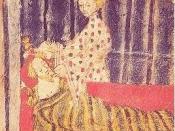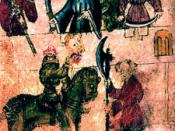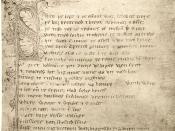In the alliterative poem, Sir Gawain and the Green Knight, both human nature and medieval chivalry are manifested. Sir Gawain bravely accepts the game of the Green Knight. Sir Gawain's shield posses a pentangle along with the face of Mary, mother of Christ. He then playfully agrees to the game proposed by the host of the castle. The protagonist, Sir Gawain, accepts a green belt from Bercilak's wife. Gawain denies the guide's offer at the woods. Sir Gawain finds the Green Knight to fulfill his part of the covenant. Finally Gawain is deemed a true knight.
A pentangle star and the face of Mary are placed on the inside of Sir Gawain's shield. The pentangle symbolizes the virtues to which Gawain aspires: to be flawless in his five senses; never to falter in his five fingers; to be faithful to the five wounds that Christ received on the cross; to be strengthened by the five joys that the Virgin Mary had in Jesus, and to possess generosity, courtesy, chastity, chivalry, and piety.
The side of the shield facing Gawain contains an image of the Virgin Mary to make sure that Gawain never loses courage. This truly shows the human nature of Gawain. The narrator explains, "Then they carried in his shield, striped with bright red; a pentangle starâ¦This fair knight had her face painted inside his shield, to stare at Heaven's Queen and keep his courage high" (619-620, 648-652). Sir Gawain, like other people, uses religious figures to comfort and seek guidance from.
The Green Knight enters the court and offers a game to the most capable knight present at the court. King Arthur steps forth to defend his court, but as he begins to swing the immense axe, Sir Gawain stands and requests to take his place.


